My bike is filthy and making strange creaking sounds. My calves are taut and strained, and my thighs burn like barbecue sausages ready to burst. But it's my backside that is giving me the most grief.
Has someone slipped a sea-urchin in my shorts? Does Sudocrem now contain chilli seeds? Is it wise in public to pop a blister on your anus? My butt is in an unhappy and dark place and winces and weeps as I ease it into the saddle.
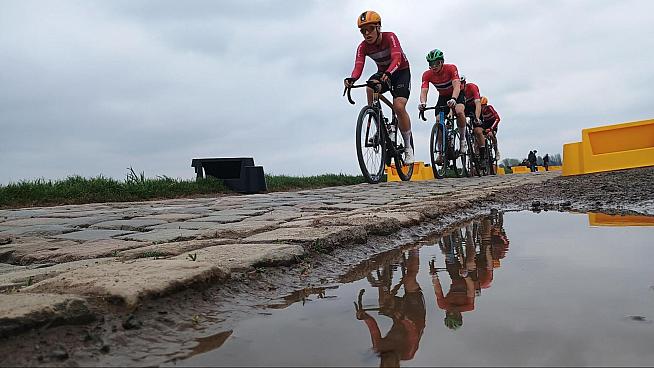
All photos Alex Beyfus & Peter Levenspiel
Feeling like this at the end of a 110 mile ride across cobbled and rutted farm tracks is to be expected. Feeling like this at the end of a big ride just adds to the sense of achievement. No pain, no glory, and all that. The famous outdoor velodrome in Roubaix where this sportive ends is bound to be filled with many riders feeling just as bad or worse than me - resting exhausted on the grass, cheerfully drinking beer in the afternoon sunshine, entertaining one another with their stories from the ride.
But I'm not in Roubaix. It is not the afternoon and I'm not drinking beer. It's half five in the morning and I've just set off from our AirBnB in Beaurevoir - which is over 10 miles from the little village of Busigny, where the 'Paris-Roubaix Challenge' starts. Forget about the end of the ride — I'm not even at the start of it yet. I'm really regretting taking on this assignment — a feeling that is made worse by the fact that I have only myself to blame.
Whose stupid idea was it to choose the longest of the three routes on offer? Mine.
Whose idea was it to try and save some money by riding 140 miles from my home in Brighton to the start via the overnight Newhaven-Dieppe ferry? Yep, that was me.
And, worst of all, who ate the five hot-cross buns yesterday morning that gave you the shits all day?
Well, you get the idea by now. I plead guilty. They were my buns, and I gobbled them down at 4am as the ferry docked, in a hasty attempt to carb-load. But, rather than topping up my glycogen ammunition for today's ride, my body rejected them and they shot through my system yesterday.
They ended up as a different kind of ammunition — turning my backside into some kind of hideous pneumatic spud gun. If it could speak, the expletives emanating from my arse's potty-mouth would be unprintable. But one question that it would clearly want an answer to is — How did I get here?
Well, for a fan of professional cycling, the chance to take on a challenge that includes all the pavé sectors of the legendary Paris-Roubaix is very tempting. And if, like me, you've been bitten by the gravel bug, there's absolutely no way you'd pass up the opportunity to take part in this event - especially as Paris-Roubaix is arguably the original gravel race.
A Potted History of L'Enfer du Nord
Dubbed L'Enfer du Nord — The Hell of the North — Paris-Roubaix celebrates the challenge of rough terrain and tests riders' endurance and skill while battering bikes and backsides. First held in 1896, this race offers a direct link to the sport's roots like no other.
The rough, cobbled, and rutted tracks the route follows across northern France were not considered unusual in Europe at the time, as most roads were of a similar quality. Riding in organized teams didn't really become established in road races until the 1930s, meaning early competitors were entirely self-sufficient. Without the luxury of a team car or domestiques, riders carried spares and tools and were forced to make roadside repairs unaided.
This made for huge time gaps between finishers — at the very first race, only four riders finished within an hour of winner Maurice Garin. So, in many ways, races from that era have more in common with today's gravel events like Unbound or The Tour Divide than with the modern road races they evolved into.
As road surfaces improved throughout the 20th century, most major races shifted toward smoother, tarmacked routes. Paris-Roubaix, however, retained its infamous cobblestone sectors - actively preserved by a dedicated group of volunteers — Les Amis de Paris-Roubaix. It has become a badge of honour for pro riders to simply finish the race, and of course the winners instantly become legends of the sport.
Since 2011, the Paris-Roubaix Challenge has offered amateur riders the chance to test their mettle on the legendary course the day before the pros tackle the same cobbled sectors. Participants can choose between 70, 145, or 170 km routes, with the longest including all 30 cobbled secteurs that the pros race over just 24 hours later. As an added bonus this year, the Paris-Roubaix Femmes — running since 2021 — took place on the same day as the sportive, with the first women pros finishing in the Roubaix velodrome within an hour of the last sportive riders.
A Saturday in Hell?
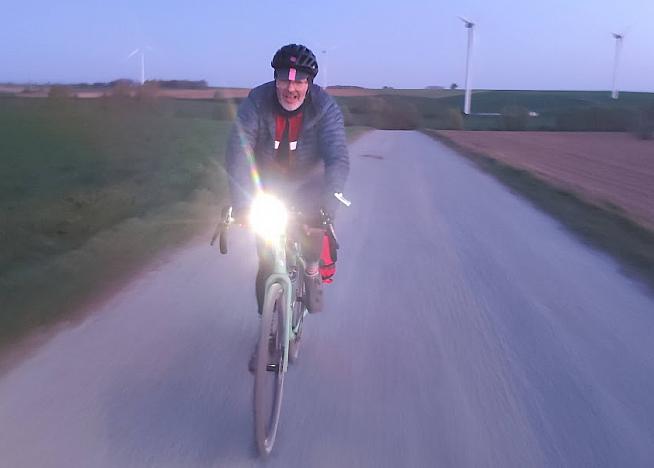
Clearly, Paris-Roubaix is a bucket-list ride, and my weepy, puffy derriere wasn't going to stop me from getting to the start line at least. Remarkably, the hot-cross bun debacle from the day before showed no signs of returning as I rode to Busigny with my companion Pete.
With over ten thousand people riding the event, the organisation at the start village was remarkably slick, with queuing time kept to a minimum. Best of all was the generous bag-drop - Pete and I were able to offload all our bike-packing gear into a huge sack, which would be delivered to Roubaix for collection at the finish. I'm not sure what the villagers in Busigny thought about YMCA being blasted out of the PA system at 6am, but it definitely stopped riders from lingering around the start.
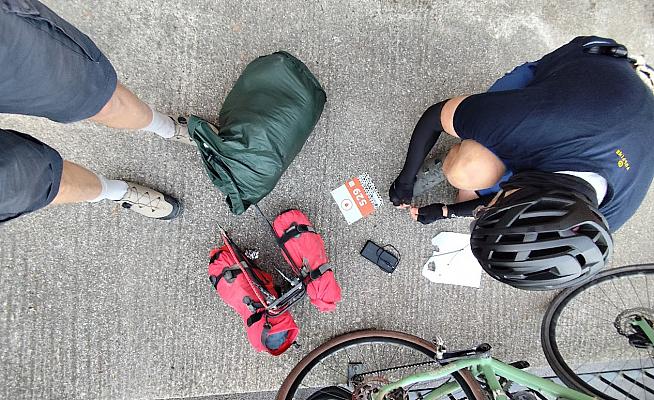
If I'm being honest when I lined up on the start line I didn't really hold out much hope of completing the event. The previous day's ride with its frequent toilet stops had scarred me. I pictured myself trundling along for the first 10 or 20 miles, before either my backside, legs, accumulated fatigue, or a combination of all three led to me climbing off the bike and jumping on the next train to Roubaix.
Catching a train to skip past the trickier bits of a course happened all the time in the early days of road-racing, so I figured I would be in good company. If I timed it right, I could get to our hotel in Roubaix, dump the bike, shower, change, and sneak a snooze. Then, after lunch — a baguette and the French equivalent of Dioralyte — I'd head to the velodrome just in time to meet Pete as he crossed the finish line. I had it all worked out.
Remarkably however, as we set off, I actually started feeling relatively fresh. Sure, every part of me ached — but only in the kind of way your body normally hurts during a hard ride. The aches and pains soon faded into the usual background body noise you get when making an effort on the bike. Partly this was thanks to the day warming up as the sun rose, but mostly it was because the stomach problems from the day before hadn't returned. By the time I hit the first cobbled section after 8 miles, I was feeling pretty good on the bike compared to when I'd left our AirBnB. I had found a second wind — the good kind.
Approaching that first secteur, I recalled the best way to ride the pavé: go hard and fast down the middle of the road, hands loosely on the tops of the bars, weight slightly lifted off the saddle. Like this, the bike seems to skip across the peaks and troughs of the cobbles — a perpetual bouncing that feels like the bike is hovering. It buzzes and jolts beneath you, like riding a galloping horse or a washing machine on its final spin. You can't shift gears easily in this position, so unless the section is short, you eventually lose momentum — and that's when things get tricky.
When the speed drops, the 'hover' that insulates you from the cobbles vanishes and you crash back to earth. Suddenly, you feel every jagged corner of every wonky cobblestone, and the gaps between them. The rhythmic buzz you felt through the bars and saddle is replaced by random kicks and jolts. That galloping horse turns into a bucking bronco — the washing machine has broken loose and is careening madly around the kitchen. Progress slows until eventually it feels like you're roller-skating across corrugated iron.
When this happens, it's best to get off the cobbled crown in the middle of the road and seek the relative calm of the earthy gutters on either side. Here, the cobbles are missing, flattened by farm traffic, or smoothed over by soil from the fields. There are still potholes, ruts, and slower riders to navigate, but it's relatively calm. Much like the slow lane on a motorway, the gutters are where the older, slower, more sensible riders end up, leaving the cobbled crown for the stronger or more masochistic.

Pete and I separate as we ride each section. It's tricky — and a little dangerous — to ride close together because you need a clear view of the hazards ahead to switch lines in time. Riders zig-zag constantly between the central cobbled crown and smoother edges, hunting for the optimal line. Hazards lurk everywhere. Riders suddenly bunny-hop an obstacle in front of you, or slam into a pothole or rut, forcing last-second changes of direction. There's no braking on the cobbles when you're riding on the tops.
Occasionally, a small train of speeding riders rushes past, kicking up a plume of dust behind them. Bidons bounce out of cages and scatter along the road. Along the edges, you see the unlucky victims and their bikes: a puncture at best, or something broken at worst. Thought your wheels were "bulletproof"? The cobbles laugh at that marketing nonsense.
An archway across the end of each secteur acts like a mini-finish line. You see it in the distance and know that once you cross it, tarmac — and relative normality — will return. Just like a real finish line, riders slow down after crossing, check themselves over, regroup with friends, then set off for the next secteur. With 54 km of the 170 km course cobbled, once the sections start, there's never long to wait until the next.
After finishing the first few secteurs, Pete and I were giddy with excitement and semi-shocked by the experience. We both agreed the cobblestones were utterly bonkers and unlike anything we'd ridden before. At first, we were evenly paced, but after about 35 miles, my energy began to dip. I struggled to hold Pete's wheel on the tarmac sections, and negative thoughts crept in. On the pavé, the time I could spend charging head-on over the cobbles at speed got shorter, while the time stuck in the gutter lengthened. The number of riders zooming past me increased, and the excitement I once felt when hitting the tarmac was replaced by simple relief.
In my head, I still believed I could finish the course, but doubts crept in about making it to Roubaix before the 4pm cut-off. Riders finishing after that are diverted away from the velodrome to avoid clashing with the women's race which ended at 4:30pm. Pete was clearly stronger, and I didn't want to hold him back or spoil his chance of finishing inside the velodrome. We agreed to ride at our own pace and meet up at the finish.
That decision brought relief — the negative thoughts were pushed aside, Pete pedaled off, and I settled into my own rhythm, happy to trundle at my own speed. But before long, the honeymoon in my head was over. My pace dropped even further. Without Pete to chat to or follow, my mind wandered, and the negative thoughts returned.
My inner chimp got especially irked when a rider sporting 'Tri-Harder' across the back of his shorts overtook me. I hated that guy. How dare his shorts mock me? My head told me to chase him down and stick my foot in his spokes, but my legs replied, "Shut up, head," and Tri-Harder guy vanished into the distance. I felt pathetic.
My mind needed resetting. I knew rational thought could drive away the chimp, so I started playing number games. Instead of just looking at my Wahoo and thinking, "I've ridden 40 miles," I began mental gymnastics: first basic subtraction — "40 down, 70 to go"; then fractions — "That's four elevenths done, seven elevenths left." After double-checking my maths and scoffing a few Haribo, a few more miles passed. "42.5 miles done — twenty-seven forty-fourths to go!" Time to reward myself with a few more sweets again.
While I did these calculations, my body rode on autopilot. Subconsciously, I'd been following other riders since I didn't have the course loaded on my Wahoo. This strategy works when thousands are riding, so I was horrified to realize there were no riders ahead. I was on a long, straight road with farmland either side — completely alone. No bikes, cars, or signs. Both Chimp and Rational Mind agreed that this couldn't be because I was the fastest rider on the road. Chimp was convinced I was dead last and that the course had been packed away ahead of me.
"Get off your bike, sit down, and cry," said Chimp.
"Yes, then call a taxi," said Rational Mind.
Not helpful. They seemed to be conspiring against me, so I tried to block them out and pushed on. I passed a couple walking by. "Où et Paris-Roubaix?" I shouted as I rode past. They looked back as if I was an idiot. Ahead, I saw a cluster of buildings, so I put my head down and ploughed on.
Soon I reached the town, and at the T-junction, dozens of riders crossed the road. "We're back on course!" said Rational Mind. His brief truce with Chimp was broken, and a wave of euphoria re-energized me.
"Yes," said Chimp, "but haven't we ridden through this town before?"
Rational Mind was lost for words. It did look familiar. The course wound back and forth through the countryside just south of Roubaix. Oh God, how many forty-fourths did I have to ride again? A feeling of dread twisted my stomach.
Then something remarkable happened — Pete rode past me with a "What the hell?" expression. He'd lost a chunk of time after a couple of punctures.
"How far to the finish?" I asked, secretly hoping I'd skipped all the 'five-star' secteurs with the worst cobbles.
"About 55 miles," he said. Tragically, our GPS units were almost in sync. I'd only gained a few miles from getting lost.
We rode together briefly, then agreed once again to ride at our own pace.
The next miles passed in a blur of mental maths and Haribo — the maths to keep Chimp quiet, the sweets to fuel my legs.
Next came secteur 19: the infamous Arenberg Trench. Feared by all, these cobbles were many times worse than any other. This 'road' looked like it had been built by 'Les Cowboy Builders et Sons', who had simply dumped truckloads of grapefruit-sized granite lumps in a straight line through the forest.
Riding Arenberg was like having your seatpost replaced with a pneumatic jackhammer. Your saddle turned into Raging Bull, your backside his punchbag. Meanwhile, your spine felt like it was being pushed through the back of your throat. No easy lines here — uniquely, this section had no smooth earth gutters on the edges. One side's grassy verge had been churned up by organizers to stop riders using it; the other was roped off and packed with spectators. Thankfully, gaps in the rope let me switch from the cobbles to the footpath, and I wasn't ashamed to take the easier route. Physically and mentally, my passage was eased through the forest.
Ticking off the Trouée d'Arenberg seemed to kill off Chimp. I even managed to enjoy the second half of the ride. My spirits lifted further when my mental maths calculated that I should finish in the velodrome with about 20 minutes to spare. Not only was I closer to the finish than the start of the sportive, but I also realised that I'd ridden over two hundred miles in less than 48 hours — about half-way through the total trip mileage. I let my mind drift, thinking ahead to Sunday, when Pete and I would have a rest day.
Soon, I passed the point at the Carrefour de l'Arbre where we planned to watch the men's race. This final 5-star secteur, less than 10 miles from the finish, is often where the decisive move by the eventual race winner happens. This year, however, the race was already all but decided by this section, with Mathieu Van der Poel powering away from Tadej Pogacar after the latter overshot a corner with 38km to go.
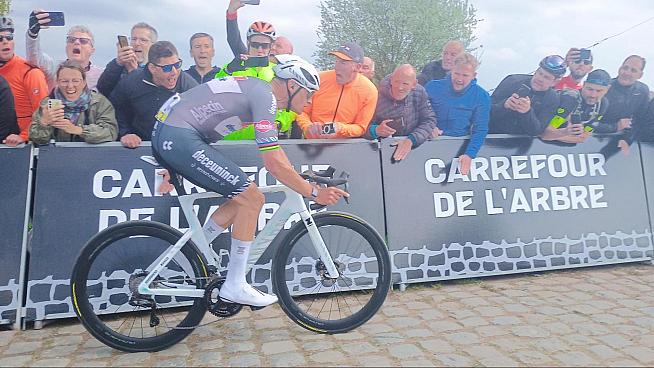
Thinking further ahead to Monday, the prospect of another century ride back to Dieppe to catch the ferry home actually felt achievable for the first time on this trip.
But all that was still in the future. Once again, it was an unexpected meeting with Pete that pulled me back to the present. He was at the side of the road on secteur 3 — Gruson — just 8 miles from the finish.
Having punctured and run out of inner tubes, he'd resigned himself to the slow, laborious task of finding and patching the puncture and probably finishing outside the cut-off time. Fortunately, I hadn't punctured once and could give him one of my spare tubes. We quickly got the tube fitted, and realised that if we got a wiggle on we still had a chance of beating the cut-off.

The last few miles, riding through the suburbs of Roubaix and into the town centre, were the fastest of the whole day. We passed quite a few riders — though my nemesis in the Tri-Harder shorts was not one of them.
The final cobbled secteur was a ceremonial stretch leading to the park where the velodrome stands. The last two hundred and twentieth of a mile was taken at a gallop, and before I could even figure out what fraction half a lap of the velodrome constituted, we crossed the finish line.
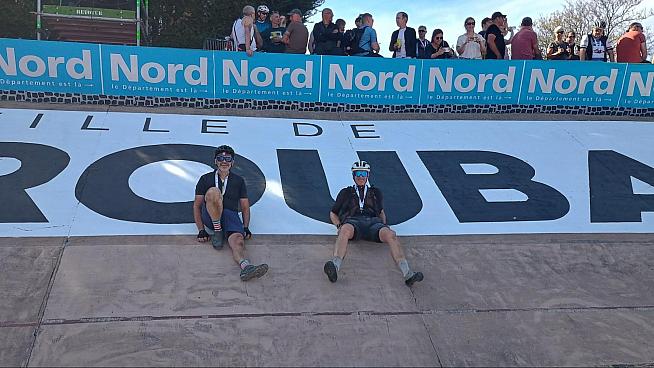
We had beaten the cut-off time and could now sit back and recover in the finish zone.
It was a glorious mid-spring afternoon. Thousands of fellow riders perched in the velodrome stands or sprawled across the park, beers in hand and finisher's medals gleaming proudly around their necks. Soon, the Paris-Roubaix Femmes would arrive, with Pauline Ferrand-Prévot — the first French victor — receiving a hero's welcome from the partisan crowd.
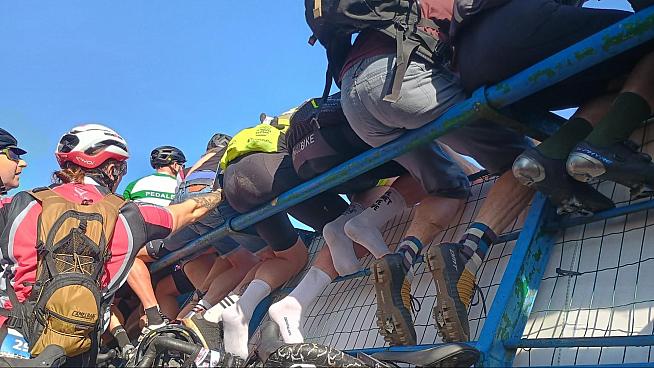
The Paris-Roubaix Challenge isn't just a sportive — it's a test of will, grit and absurdity. Whether you're a gravel-head or roadie, it'll stretch both mind and body to their limits. The organisation is faultless, the atmosphere unforgettable, and the cobbles... completely, comically brutal.
For me, the Paris-Roubaix Challenge isn't just a challenge — it's the ultimate bad-ass ride.
Thank you to ASO for providing entries for Alex and Peter at this year's Paris-Roubaix.
The Paris-Roubaix Challenge will return on 11 April 2026. Find out more and pre-register now at www.parisroubaixchallenge.com.
0 Comments





